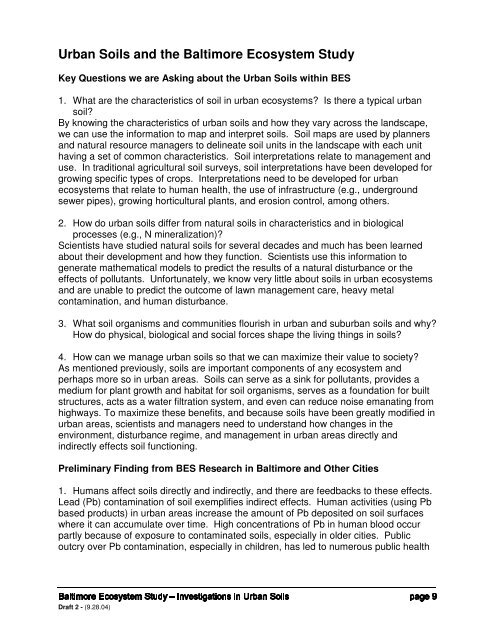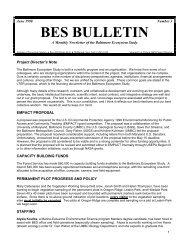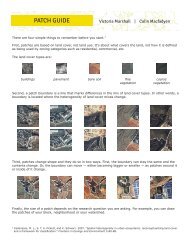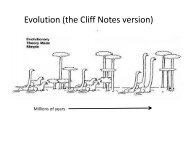Investigations in Urban Soils - Baltimore Ecosystem Study
Investigations in Urban Soils - Baltimore Ecosystem Study
Investigations in Urban Soils - Baltimore Ecosystem Study
You also want an ePaper? Increase the reach of your titles
YUMPU automatically turns print PDFs into web optimized ePapers that Google loves.
<strong>Urban</strong> <strong>Soils</strong> and the <strong>Baltimore</strong> <strong>Ecosystem</strong> <strong>Study</strong><br />
Key Questions we are Ask<strong>in</strong>g about the <strong>Urban</strong> <strong>Soils</strong> with<strong>in</strong> BES<br />
1. What are the characteristics of soil <strong>in</strong> urban ecosystems? Is there a typical urban<br />
soil?<br />
By know<strong>in</strong>g the characteristics of urban soils and how they vary across the landscape,<br />
we can use the <strong>in</strong>formation to map and <strong>in</strong>terpret soils. Soil maps are used by planners<br />
and natural resource managers to del<strong>in</strong>eate soil units <strong>in</strong> the landscape with each unit<br />
hav<strong>in</strong>g a set of common characteristics. Soil <strong>in</strong>terpretations relate to management and<br />
use. In traditional agricultural soil surveys, soil <strong>in</strong>terpretations have been developed for<br />
grow<strong>in</strong>g specific types of crops. Interpretations need to be developed for urban<br />
ecosystems that relate to human health, the use of <strong>in</strong>frastructure (e.g., underground<br />
sewer pipes), grow<strong>in</strong>g horticultural plants, and erosion control, among others.<br />
2. How do urban soils differ from natural soils <strong>in</strong> characteristics and <strong>in</strong> biological<br />
processes (e.g., N m<strong>in</strong>eralization)?<br />
Scientists have studied natural soils for several decades and much has been learned<br />
about their development and how they function. Scientists use this <strong>in</strong>formation to<br />
generate mathematical models to predict the results of a natural disturbance or the<br />
effects of pollutants. Unfortunately, we know very little about soils <strong>in</strong> urban ecosystems<br />
and are unable to predict the outcome of lawn management care, heavy metal<br />
contam<strong>in</strong>ation, and human disturbance.<br />
3. What soil organisms and communities flourish <strong>in</strong> urban and suburban soils and why?<br />
How do physical, biological and social forces shape the liv<strong>in</strong>g th<strong>in</strong>gs <strong>in</strong> soils?<br />
4. How can we manage urban soils so that we can maximize their value to society?<br />
As mentioned previously, soils are important components of any ecosystem and<br />
perhaps more so <strong>in</strong> urban areas. <strong>Soils</strong> can serve as a s<strong>in</strong>k for pollutants, provides a<br />
medium for plant growth and habitat for soil organisms, serves as a foundation for built<br />
structures, acts as a water filtration system, and even can reduce noise emanat<strong>in</strong>g from<br />
highways. To maximize these benefits, and because soils have been greatly modified <strong>in</strong><br />
urban areas, scientists and managers need to understand how changes <strong>in</strong> the<br />
environment, disturbance regime, and management <strong>in</strong> urban areas directly and<br />
<strong>in</strong>directly effects soil function<strong>in</strong>g.<br />
Prelim<strong>in</strong>ary F<strong>in</strong>d<strong>in</strong>g from BES Research <strong>in</strong> <strong>Baltimore</strong> and Other Cities<br />
1. Humans affect soils directly and <strong>in</strong>directly, and there are feedbacks to these effects.<br />
Lead (Pb) contam<strong>in</strong>ation of soil exemplifies <strong>in</strong>direct effects. Human activities (us<strong>in</strong>g Pb<br />
based products) <strong>in</strong> urban areas <strong>in</strong>crease the amount of Pb deposited on soil surfaces<br />
where it can accumulate over time. High concentrations of Pb <strong>in</strong> human blood occur<br />
partly because of exposure to contam<strong>in</strong>ated soils, especially <strong>in</strong> older cities. Public<br />
outcry over Pb contam<strong>in</strong>ation, especially <strong>in</strong> children, has led to numerous public health<br />
Draft 2 - (9.28.04)<br />
<strong>Baltimore</strong> <strong>Ecosystem</strong> <strong>Study</strong> – <strong>Investigations</strong> <strong>in</strong> <strong>Urban</strong> <strong>Soils</strong><br />
page 9






